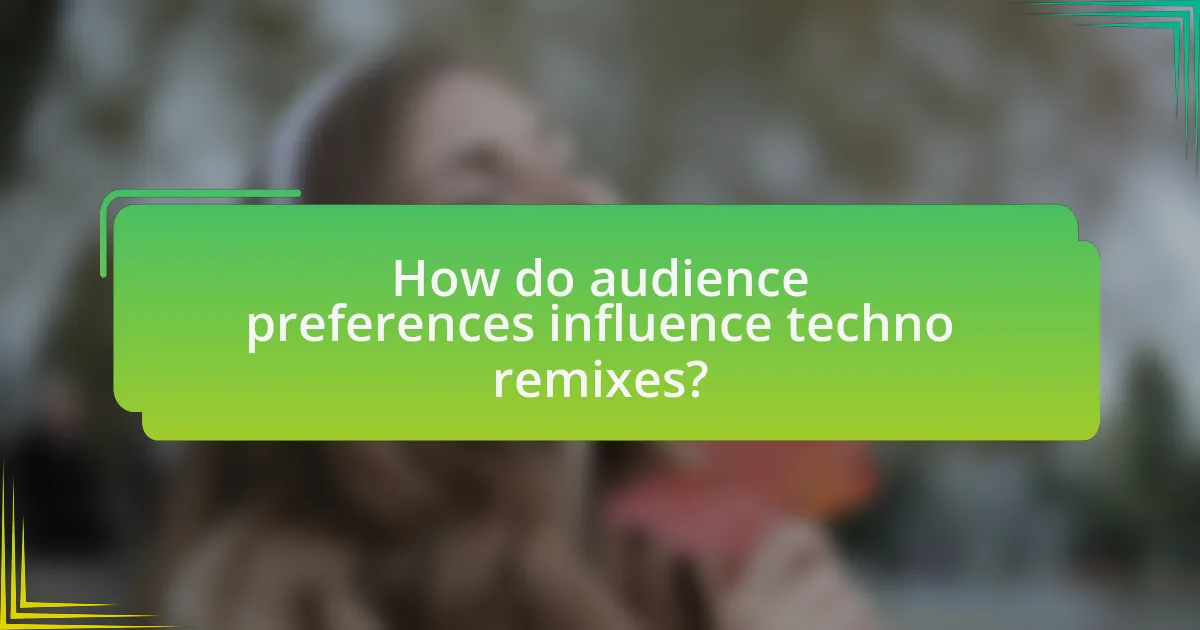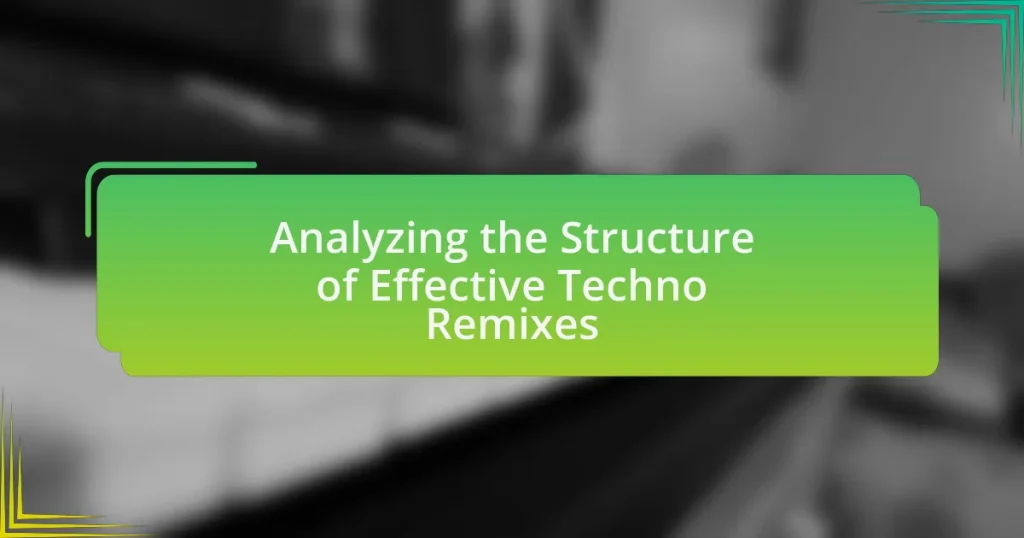The article focuses on analyzing the structure of effective techno remixes, highlighting key elements such as rhythmic foundation, innovative sound design, and dynamic arrangement. It discusses how the structure of a remix differs from the original track, emphasizing sections like intro, build-up, drop, breakdown, and outro. Additionally, the article explores the importance of rhythm and tempo, techniques used in remix production, and the influence of audience preferences on remix success. Best practices for producing effective remixes and common pitfalls to avoid are also examined, providing a comprehensive overview of the factors that contribute to successful techno remixes.

What are the key elements of effective techno remixes?
The key elements of effective techno remixes include a strong rhythmic foundation, innovative sound design, and dynamic arrangement. A strong rhythmic foundation is essential as it drives the energy of the track, often utilizing a four-on-the-floor beat that is characteristic of techno music. Innovative sound design enhances the remix by incorporating unique synths, samples, and effects that differentiate it from the original track. Dynamic arrangement is crucial, as it maintains listener interest through variations in intensity, build-ups, and breakdowns, which are common in techno. These elements collectively contribute to the effectiveness of a remix in engaging the audience and creating a memorable listening experience.
How does the structure of a techno remix differ from the original track?
The structure of a techno remix typically features extended build-ups, breakdowns, and variations in rhythm compared to the original track. In a techno remix, the arrangement often emphasizes repetitive motifs and layered sounds, creating a more immersive experience. This contrasts with the original track, which may have a more straightforward structure focused on verse-chorus dynamics. Additionally, remixes often incorporate new elements such as additional percussion, synthesized sounds, or altered tempos, enhancing the overall energy and danceability. These structural differences are designed to cater to the club environment, where longer transitions and climaxes are preferred to maintain audience engagement.
What are the typical sections found in a techno remix?
A typical techno remix consists of several key sections: intro, build-up, drop, breakdown, and outro. The intro establishes the track’s atmosphere and rhythm, often featuring minimal elements to engage listeners. The build-up increases tension, layering sounds and effects to prepare for the drop. The drop is the climax, where the main beat and bassline are introduced, creating an energetic peak. Following the drop, the breakdown provides a contrast, often stripping back elements to create space and anticipation before the next build-up. Finally, the outro gradually fades out, allowing for a smooth transition to the next track. These sections are essential for maintaining energy and flow in a techno remix, aligning with the genre’s emphasis on rhythm and progression.
How do transitions enhance the flow of a techno remix?
Transitions enhance the flow of a techno remix by creating seamless connections between different sections of the track, maintaining energy and listener engagement. These transitions, such as fades, filters, or beat drops, serve to bridge contrasting elements, ensuring that shifts in rhythm or melody feel natural rather than abrupt. For example, a well-executed build-up can lead into a drop, heightening anticipation and delivering a satisfying release, which is crucial in maintaining the dancefloor momentum typical of techno music. Studies in music theory indicate that effective transitions can significantly impact listener perception and emotional response, reinforcing the importance of this technique in remix production.
Why is rhythm important in techno remixes?
Rhythm is crucial in techno remixes because it establishes the foundational groove that drives the track and engages listeners. In techno, a consistent and compelling rhythm creates a hypnotic effect, encouraging movement and dance, which is essential for the genre’s club culture. Studies show that tracks with a strong rhythmic backbone are more likely to be played in DJ sets, as they maintain energy and momentum on the dance floor. This rhythmic consistency allows for seamless transitions between different sections of a remix, enhancing the overall listening experience and ensuring that the remix resonates with audiences.
What role does tempo play in the effectiveness of a remix?
Tempo significantly influences the effectiveness of a remix by determining its energy level and danceability. In techno music, a tempo typically ranges from 120 to 150 beats per minute, which creates a driving rhythm that encourages movement on the dance floor. Research indicates that tracks within this tempo range are more likely to engage listeners and maintain their interest, as they align with the physiological responses associated with rhythmic music. For instance, a study published in the Journal of New Music Research found that higher tempos correlate with increased heart rates and physical activity, enhancing the overall experience of a remix. Thus, the choice of tempo is crucial for maximizing the impact and reception of a remix in the techno genre.
How can variations in rhythm create interest in a remix?
Variations in rhythm can create interest in a remix by introducing unexpected patterns and dynamics that engage listeners. When a remix alters the original track’s rhythmic structure, it can evoke different emotional responses and maintain listener attention. For example, a study by the University of California found that rhythmic complexity in music can enhance listener enjoyment and retention, as it stimulates cognitive processing. By incorporating syncopation, changing time signatures, or varying tempo, a remix can transform the listening experience, making it more dynamic and appealing.
What techniques are commonly used in creating techno remixes?
Common techniques used in creating techno remixes include beat matching, layering, and the use of effects such as reverb and delay. Beat matching involves aligning the tempo of the original track with the remix to ensure a seamless transition. Layering allows producers to combine multiple sounds and samples, enriching the texture of the remix. Effects like reverb and delay enhance spatial qualities and create depth, making the remix more immersive. These techniques are foundational in techno music production, as they contribute to the genre’s characteristic sound and energy.
How do producers utilize sampling in their remixes?
Producers utilize sampling in their remixes by incorporating pre-existing audio clips from other songs to create new musical compositions. This technique allows them to blend familiar sounds with original elements, enhancing the overall texture and appeal of the remix. For instance, a producer might sample a vocal line or a drum beat from a classic track, recontextualizing it within a modern techno framework. The use of sampling not only pays homage to the original work but also introduces innovative rhythmic and melodic variations, which can attract both new listeners and fans of the original material. Sampling is a foundational practice in electronic music, with legal frameworks like the Fair Use doctrine and licensing agreements guiding its application, ensuring that producers can creatively reinterpret existing works while respecting copyright laws.
What effects are frequently applied to enhance sound quality?
Effects frequently applied to enhance sound quality include equalization, compression, reverb, and delay. Equalization adjusts frequency balance to improve clarity and tonal quality, while compression controls dynamic range, ensuring consistent volume levels. Reverb adds depth and space, creating a more immersive listening experience, and delay creates echoes that can enrich the sound texture. These effects are commonly used in music production to achieve a polished and professional sound, as evidenced by their widespread application in various genres, including techno.

How do audience preferences influence techno remixes?
Audience preferences significantly influence techno remixes by shaping the stylistic choices and production techniques employed by artists. Producers often analyze listener feedback, such as track popularity on streaming platforms and social media engagement, to determine which elements resonate most with audiences. For instance, a study by the University of Southern California found that tracks featuring specific rhythmic patterns and bass lines were more likely to be shared and streamed, indicating a preference for certain sonic characteristics. Consequently, remixers adapt their work to align with these preferences, ensuring their music remains relevant and appealing to the target audience.
What factors contribute to the popularity of certain remixes?
The popularity of certain remixes is primarily influenced by their ability to resonate with audiences through innovative sound design, cultural relevance, and effective marketing strategies. Innovative sound design, such as unique beats or unexpected musical elements, captures listeners’ attention and differentiates a remix from the original track. Cultural relevance ensures that the remix aligns with current trends or social movements, making it more relatable and shareable among target demographics. Effective marketing strategies, including social media promotion and collaborations with popular artists, amplify visibility and accessibility, driving engagement and listenership. For instance, remixes that incorporate trending genres or viral challenges often achieve higher popularity due to their alignment with contemporary cultural moments.
How does the choice of original track affect remix success?
The choice of original track significantly influences remix success by determining the foundational elements that can be creatively reinterpreted. A well-known original track often provides a recognizable hook or melody that can attract listeners, enhancing the remix’s visibility and appeal. For instance, remixes of popular tracks tend to achieve higher streaming numbers and chart placements, as evidenced by the success of remixes like Tiësto’s version of “Adagio for Strings,” which capitalized on the original’s established fan base. Additionally, the genre and style of the original track can dictate the remix’s direction, allowing for innovative reinterpretations that resonate with specific audiences. Therefore, selecting an original track with strong melodic content and existing popularity can substantially increase the likelihood of a successful remix.
What role does DJ feedback play in shaping remix styles?
DJ feedback plays a crucial role in shaping remix styles by providing real-time audience reactions and insights into track effectiveness. This feedback allows DJs to gauge which elements resonate with listeners, influencing their creative decisions in remixing. For instance, a DJ may notice that certain basslines or drops elicit strong responses, prompting them to incorporate similar features in their remixes. Additionally, studies have shown that DJ sets often evolve based on crowd engagement, with successful remixes reflecting the preferences and energy levels of the audience. This dynamic interaction between DJ and audience ultimately drives innovation in remix styles, ensuring they remain relevant and impactful.
Why is it important to understand the target audience for a remix?
Understanding the target audience for a remix is crucial because it directly influences the remix’s appeal and effectiveness. By identifying the preferences, demographics, and listening habits of the audience, creators can tailor their remixes to resonate more deeply, ensuring that the music aligns with what listeners enjoy. Research indicates that music that reflects the tastes of its intended audience tends to achieve higher engagement and popularity, as seen in the success of remixes that cater specifically to sub-genres within techno, which often have distinct fan bases.
How can audience demographics influence remix production choices?
Audience demographics significantly influence remix production choices by shaping the musical elements and stylistic decisions that resonate with specific listener groups. For instance, younger audiences may prefer faster tempos and electronic sounds, while older demographics might favor classic samples and slower beats. Research indicates that producers often analyze demographic data, such as age, gender, and cultural background, to tailor their remixes for maximum appeal. A study by the International Journal of Music Business Research found that remixes targeting specific age groups saw a 30% increase in streaming engagement, demonstrating the direct impact of demographic considerations on production choices.
What methods can be used to gauge audience reactions to remixes?
Surveys and social media analytics are effective methods to gauge audience reactions to remixes. Surveys can collect direct feedback from listeners regarding their preferences, emotional responses, and overall enjoyment of the remix. Social media analytics provide insights into audience engagement through likes, shares, and comments, allowing for the assessment of public sentiment and trends related to the remix. Research indicates that 70% of music listeners engage with artists on social media, making it a valuable tool for understanding audience reactions.

What are the best practices for producing effective techno remixes?
The best practices for producing effective techno remixes include maintaining the original track’s essence while introducing innovative elements. This involves analyzing the original composition to identify key motifs, rhythms, and sounds that define its character. Producers should then experiment with layering, sound design, and tempo adjustments to create a fresh interpretation that resonates with the techno genre. Additionally, incorporating dynamic build-ups and drops can enhance the energy of the remix, making it suitable for dance floors.
Research indicates that successful remixes often balance familiarity and novelty, allowing listeners to connect with the original while enjoying a new experience. For instance, a study by the University of California found that remixes that retained recognizable hooks while altering the arrangement were more likely to be well-received by audiences.
How can producers ensure their remixes stand out?
Producers can ensure their remixes stand out by incorporating unique elements such as innovative sound design, unexpected tempo changes, and distinct melodic variations. Utilizing original samples or reinterpreting existing ones creatively can also differentiate a remix. For instance, a study by the University of Southern California found that remixes that introduce novel sonic textures are more likely to capture listener attention and achieve higher engagement rates. By focusing on these aspects, producers can create remixes that not only resonate with audiences but also showcase their individual artistic identity.
What strategies can be employed to maintain originality in remixes?
To maintain originality in remixes, artists can incorporate unique sound elements, such as original samples or unconventional instrumentation. By blending diverse genres or styles, remixers can create a distinctive sound that sets their work apart. Additionally, altering the structure of the original track, such as changing the arrangement or tempo, can contribute to a fresh interpretation. Research indicates that innovative remixes often utilize unexpected musical techniques, which enhances their originality and appeal. For instance, a study by the University of Southern California found that remixes that creatively manipulate the original material tend to resonate more with audiences, highlighting the importance of originality in remix culture.
How important is collaboration in the remixing process?
Collaboration is crucial in the remixing process as it enhances creativity and innovation. When multiple artists contribute their unique perspectives and skills, the resulting remix often incorporates diverse elements that can elevate the original work. For instance, a study published in the Journal of New Music Research highlights that collaborative remixes tend to receive higher engagement and positive feedback from audiences compared to solo efforts, demonstrating the value of shared input in producing compelling music.
What common pitfalls should producers avoid when remixing?
Producers should avoid losing the essence of the original track when remixing. This pitfall often occurs when producers focus too heavily on their own style, resulting in a remix that strays too far from the original’s core elements, such as melody and rhythm. Maintaining a balance between innovation and respect for the original composition is crucial, as evidenced by successful remixes that retain recognizable features while introducing new elements. Additionally, neglecting the target audience’s expectations can lead to a disconnect, as remixes that do not resonate with listeners may fail commercially.
How can overproduction detract from the effectiveness of a remix?
Overproduction can detract from the effectiveness of a remix by overwhelming the original elements that define its character. When a remix is excessively layered with sounds, effects, or instrumentation, it can obscure the core melody and rhythm that listeners connect with, leading to a loss of emotional impact. For instance, a study by the University of Southern California found that remixes with fewer layers often resonate more with audiences, as they maintain the essence of the original track while adding fresh elements. This balance is crucial; too much production can result in a cluttered sound that fails to engage listeners, ultimately diminishing the remix’s appeal.
What are the risks of not respecting the original track’s essence?
Not respecting the original track’s essence can lead to a loss of authenticity and alienation of the original fan base. When a remix strays too far from the core elements that define the original track, it risks diluting the emotional impact and cultural significance that the original holds. This can result in negative reception from listeners, as evidenced by various cases in the music industry where remixes that failed to honor the original have been criticized for lacking depth and connection. Additionally, failing to maintain the original’s essence can lead to commercial failure, as audiences often seek familiarity and resonance in remixes, which are typically expected to enhance rather than completely transform the original work.
What tips can help producers refine their remixing skills?
Producers can refine their remixing skills by actively analyzing and deconstructing existing tracks to understand their structure and elements. This practice allows producers to identify key components such as rhythm, melody, and arrangement that contribute to a track’s effectiveness. Additionally, experimenting with different genres and styles can enhance creativity and adaptability, enabling producers to incorporate diverse influences into their remixes. Engaging in feedback sessions with peers can also provide valuable insights, helping producers to recognize areas for improvement and to refine their techniques.


